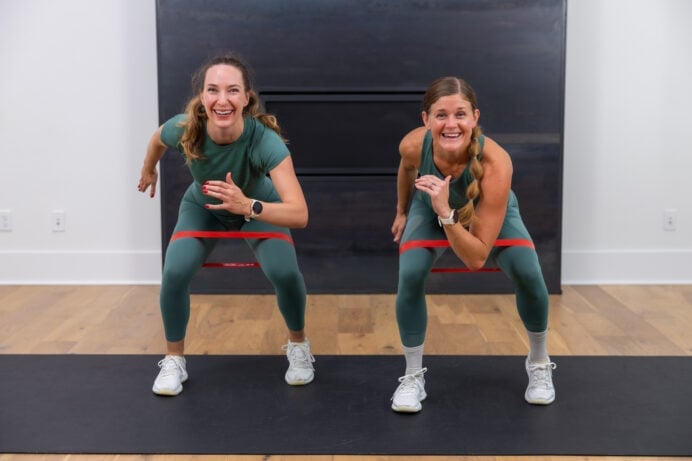
35-Minute Full-Body Strength and Conditioning Workout
This 35-minute strength and conditioning workout combines functional strength moves with high-intensity exercises to build muscle, boost endurance and improve overall performance. By combining aerobic, anaerobic and mobility-focused conditioning with resistance training, you get a full-body session that will improve your strength, speed and recovery.
Looking for a quick, effective workout that fits into your busy day? You’re in the right place. This 35-minute strength and conditioning workout is designed for women like you who want to combine functional strength moves with high-intensity cardio to challenge your whole body and boost your energy, all from the comfort of home.
Strength and conditioning workouts are all about building muscle while also improving how efficiently your body moves and recovers. Think of pairing a foundational strength move like a squat with a dynamic conditioning exercise like a squat jump. You get the benefits of both strength training and power in one efficient workout.
I like to add conditioning workouts to my home workout routine 2-3 times a week because they leave me feeling stronger, faster and more energized. As a former college athlete, I love a workout that leaves me feeling strong and athletic. That’s why I love conditioning workouts – they’re great when you’re short on time but still want full-body training sessions that target everything.
There are 3 main types of conditioning: aerobic (endurance), anaerobic (high-intensity bursts) and mobility-focused (range of motion and joint health). Incorporating all 3 helps build a well-rounded, resilient body that performs better in and out of the gym.
While traditional cardio focuses mainly on cardiovascular endurance, conditioning goes a step further by improving agility, speed, power and muscular endurance. When you combine conditioning with resistance training, you improve strength and stamina all in one workout.
STAY HYDRATED
My Favorite Electrolytes
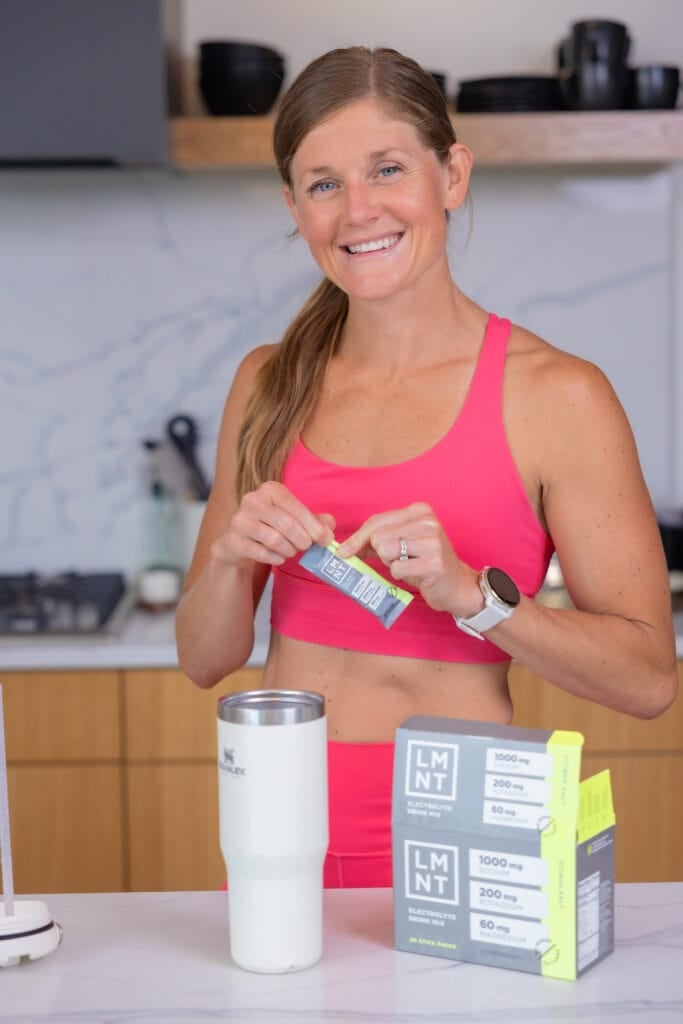
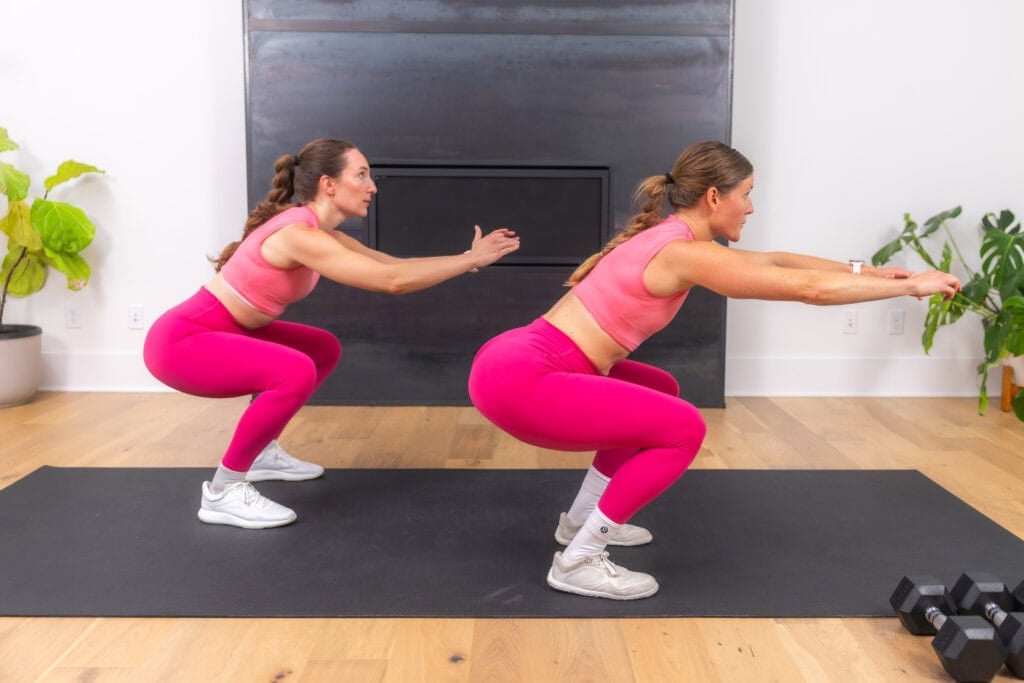
Workout Details
This 35-minute session is fast, functional and effective. Whether you’re a beginner or an experienced athlete, this strength and conditioning workout can be scaled to meet your needs.
Adding conditioning workouts like this one to your training program 1-2 times a week will lead to better endurance, improved strength and faster recovery. If you’re interested in a 2-week conditioning program, try my MetCon 100 Workout Program.
Workout Equipment
Medium to Heavy Set of Dumbbells. I recommend between 5-25 lbs, depending on your fitness level. I’m using 15-25 lb dumbbells in today’s dumbbell HIIT workout.
Workout Instructions
Follow along with the guided Conditioning Workout on YouTube, led by me — your certified personal trainer, Lindsey Bomgren.
Your Workout Looks Like This:
- Guided Warm-Up and Cool-Down
- 6 Superset Circuits
- 2 Exercises Per Circuit (1 strength exercise, 1 conditioning exercise)
- Timed Intervals (40-second work periods, 15-second rest periods for the strength exercise and 30-second work periods, 15-second rest periods for the conditioning exercise. Perform as many reps as possible while maintaining proper form during the timed intervals.)
- Repeat Each Circuit x2 Sets
Workout Outline
Circuit 1:
Circuit 2:
Circuit 3:
Circuit 4:
Circuit 5:
Circuit 6:
1. Squats
Targets: Lower body – glutes, quadriceps, hamstrings, hips and core.
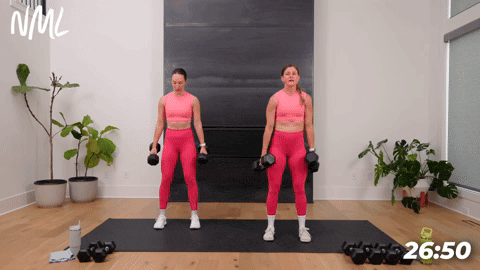
How to Do a Squat
- Start standing feet shoulder-width apart and knees slightly bent, holding a pair of dumbbells at your sides.
- Lower down into a squat position, lowering your hips down parallel with your knees. Drive your knees out toward your outer toes.
- Drive through your heels to stand tall, returning to a standing position.
2. Squat Jumps
Targets: Glutes, quads, hamstrings, calves and core.
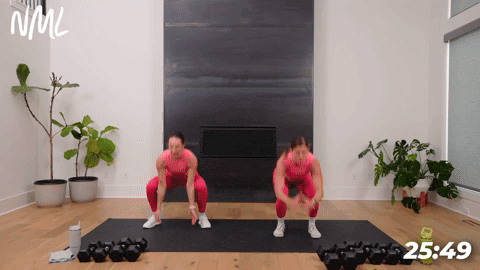
How to Do a Squat Jump
- Start standing with feet shoulder-width apart, knees slightly bent and arms at your sides.
- Lower down into a squat position, bringing your hips back and down until they’re about parallel with your knees. Keep your chest lifted and core engaged.
- Drive through your heels to explode upward into a jump, swinging your arms up for momentum.
- Land softly back into a squat position, knees bent to absorb impact.
Modification: Option to reduce the impact of this exercise by skipping the jump and rising onto your toes instead.
3. Push-Up and Back Row
Targets: Back, chest, shoulders, triceps, abs, obliques and core muscles.
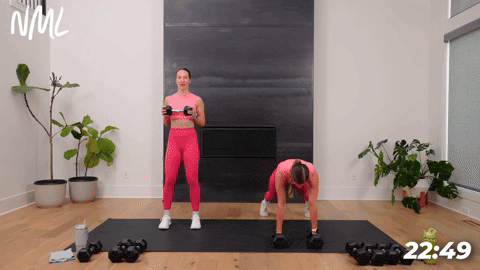
How to Do a Push-Up and Back Row
- Start in a high plank position with your shoulders stacked over your wrists. Place your hands on a pair of dumbbells. Pull your kneecaps up towards your belly, feet hip-width apart.
- Hold this plank position, maintaining a straight line with your body, and gaze slightly in front of you.
- Slowly lower your chest down towards the ground as your elbows fall back towards your hips (not out to the sides).
- Once at the bottom of your push-up, exhale as you push back up into a high plank position.
- Perform a single-arm dumbbell row on the right arm by pulling your right elbow up to meet your right rib cage. Squeeze your back muscles as you keep your shoulder down and back.
- Control the dumbbell back down to the starting position and repeat the push-up.
Modification: Perform a dumbbell press out and back row. Hold one dumbbell horizontally between your hands. Press the dumbbell straight out in front of your chest, then hinge at the hips and pull the dumbbell straight back, elbows meeting hips.
4. Dumbbell Burpee
Targets: Total body — legs, hip flexors, calves, arms, shoulders, back, abs and core.
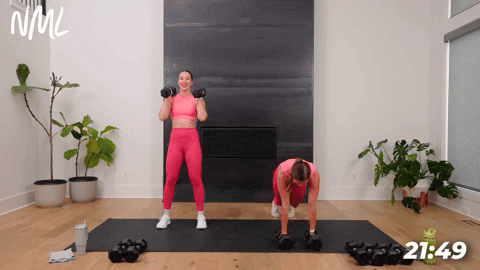
How to Do a Dumbbell Burpee
- Stand with feet hip-distance apart or a little wider. Hold a pair of dumbbells in front of you, just in front of your hips.
- Engage your core and lower your hips down to the bottom of a squat as you place the dumbbells on the ground between your feet.
- Step or jump both feet back to a high plank position. Make a straight line with your body from head to feet.
- Pause for a moment, then in one explosive movement, jump both feet forward and land just outside your hands or dumbbells.
- You should land in a deep squat from which you explosively stand up, pulling the dumbbells up.
Modification: Option to sub a squat thruster. Or, make the dumbbell burpee low impact by stepping back to plank and walking your feet back into the bottom of the low squat instead of jumping back and jumping in.
5. Split Lunge
Targets: Glutes, quads, hamstrings, hip flexors, calves, adductors and core.
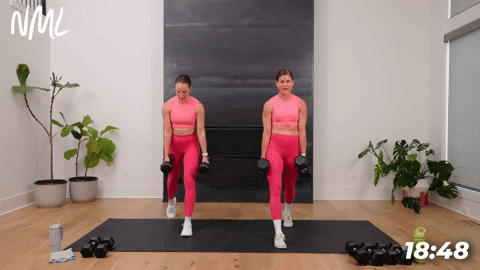
How to Do a Split Lunge
- Stand with your feet hip-distance apart, slight bend in your knees and core engaged. Hold a pair of dumbbells at your sides, palms facing in towards your body.
- Find a split lunge stance by stepping your left foot back, right leg forward.
- Drop the left knee down to the mat on a slow and controlled 2-count, finding a reverse lunge position, aiming for 90-degree angles in each knee.
- Drive through the front right heel to stand tall on a 1-count.
6. Lunge Jumps
Targets: Glutes, hamstrings, quads and thighs.
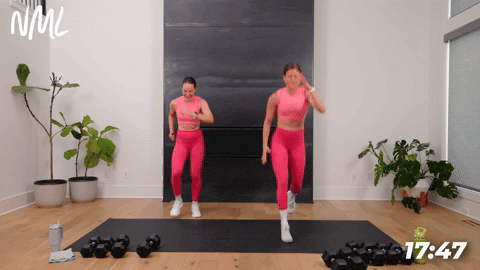
How to Do a Lunge Jump
- Stand with feet hip-distance apart and shoulders stacked over hips.
- Hop your left leg back into a reverse lunge position, lowering your hips until both knees reach a 90-degree angle. Your front thigh should be parallel to the floor.
- Explode up and back to the starting position, hopping your left leg to return to standing.
Modification: If lunges hurt your knees, substitute one of these lunge alternatives.
7. Seated Shoulder Press
Targets: Shoulders and upper arms, hips and core.

How to Do a Seated Shoulder Press
- Start sitting flat on your mat, sending the legs straight out in front of you, forming a “V” shape with your legs. Hold a pair of dumbbells front-racked at your shoulders.
- Engage your core and exhale as you press the dumbbells directly overhead until your arms are fully extended.
- Slowly and with control, lower the dumbbells down to the starting position at shoulder level and repeat.
Modification: Take this from a standing position if you’d prefer.
8. Mountain Climbers
Targets: Upper abs, lower abs, obliques, shoulders, glutes and thighs.
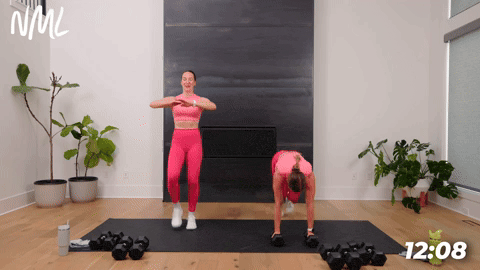
How to Do a Mountain Climber
- Start in a high plank position with your shoulders stacked over your wrists, weight evenly distributed amongst all ten fingers. Pull your kneecaps up towards your belly.
- Hold this position, maintaining a straight line with your body, and gaze slightly in front of you.
- Drive your right knee towards your left elbow before quickly driving your left knee towards your right elbow.
- Continue this pattern, alternating knee drives towards your chest at a rapid pace, as if “running” in a plank position.
Modification: Perform alternating marches or high knees by driving your knee up and in line with your hip.
9. Lateral Lunge
Targets: Gluteus medius (outer glute that controls hip movement and side-to-side movements), quads, inner thighs (or hip adductors), hamstrings and calves.
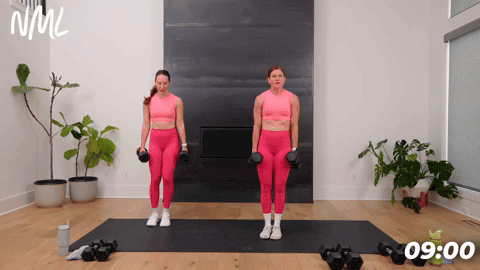
How to Do a Lateral Lunge
- Start standing, feet hip-width apart and holding a pair of dumbbells.
- Step out with your right foot, shifting your weight into your right heel as you push your hips back, bending your right knee while leaving your left leg straight. Think of performing a single-leg squat with your right leg.
- Drive through your right foot to reverse the movement, pushing you back to center.
10. Lateral Bounds
Targets: Glutes (outer gluteus medius), hips, calves, quads and core (for stability and balance).
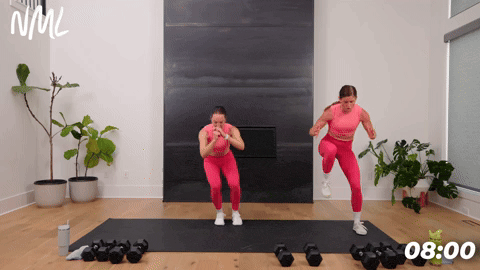
How to Do a Lateral Bound
- Start standing in an athletic stance, feet hip-width apart, knees slightly bent, core engaged.
- Push off your right foot to jump laterally to the left, landing in a loaded position on your left foot. Your left knee is slightly bent and your right knee is bent at 90 degrees. Aim to get your right knee in line with your right hip.
- Drive off your planted left foot to jump laterally to the right. Land softly on your right foot. Now your right knee is slightly bent and your left knee is bent at 90 degrees. Aim to get your left knee in line with your left hip.
Modification: Omit the balance challenge and jump laterally left and right, landing on both feet for stability.
11. Dead Bug
Targets: Deep core muscles (transverse abdominis), lower abs, hips, shoulders and back (posterior and anterior deltoids).

How to Do a Dead Bug
- Lie on your back flat on the floor, performing a slight pelvic tilt to press your lower back into the mat. Lift your knees to form a 90-degree angle (knees stacked on top of hips).
- Hold a dumbbell in each hand and extend your hands straight overhead toward the ceiling. Inhale, letting your belly expand.
- Exhale, engaging your core and simultaneously extending your left leg and right arm away from your body, lowering the dumbbell in your right arm towards the ground with control. Left arm and right leg remain in place. With control, inhale as you return to the starting position.
- Then repeat on the opposite side, exhaling as you extend your right leg and left arm away from the body, lowering the dumbbell in your left arm towards the ground. With control, return to the starting position.
Modification: Perform this exercise with no equipment, opting for a bodyweight dead bug instead.
12. Sprinter Sit-Up
Targets: Abs, core and back.
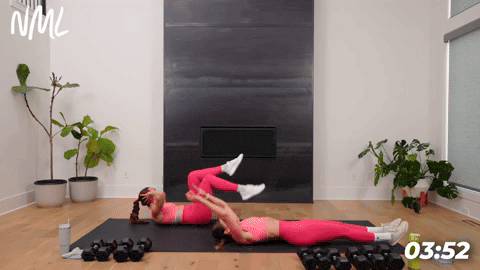
How to Do a Sprinter Sit-Up
- Start seated with your knees bent and your feet flat on the floor.
- Keeping your core engaged, lean your torso back to lay flat on the ground. Send your arms overhead and your legs long so your body forms a straight line.
- Explosively pull your torso back to an upright position to perform a sit-up while pulling your right knee toward your chest and shooting the left arm forward, performing a jab.
- With control, lower back down to the mat.
- Repeat, alternating the leg that pulls in and the arm that punches across with each rep.
Modification: Option to perform bicycle crunches.
FAQs
As a beginner, you should start strength and conditioning by focusing on proper form and bodyweight exercises. Prioritize compound movements like squats, deadlifts, push-ups, lunges and jumping jacks. As you progress, add light weights and more difficult plyometric exercises like box jumps. Gradually and increase the frequency of your training as you feel comfortable, but listen to your body and take rest as needed. If you experience DOMS (delayed onset muscle soreness) from new activity, you may benefit from restorative practices like red light therapy or cold plunging.
Cardio typically refers to steady-state aerobic exercises that increase your heart rate, like running, cycling or swimming. These exercises improve your cardiovascular health or your heart and lung endurance. Conditioning typically includes cardio but also incorporates high-intensity, varied workouts (like sprints, circuits or CrossFit) to improve your overall athletic performance. Endurance, strength, speed and recovery are all important when you’re training conditioning.
The “5-4-3-2-1 workout method” refers to a workout format. It’s a countdown of reps (5, 4, 3, 2, 1), often with the weight going up as the reps go down. It can refer to a full-body workout with 5 segments targeting cardio, legs, upper body, core and finishing with a final cardio push.
More Workouts
Full BodyPin This 35-Minute Strength and Conditioning Workout
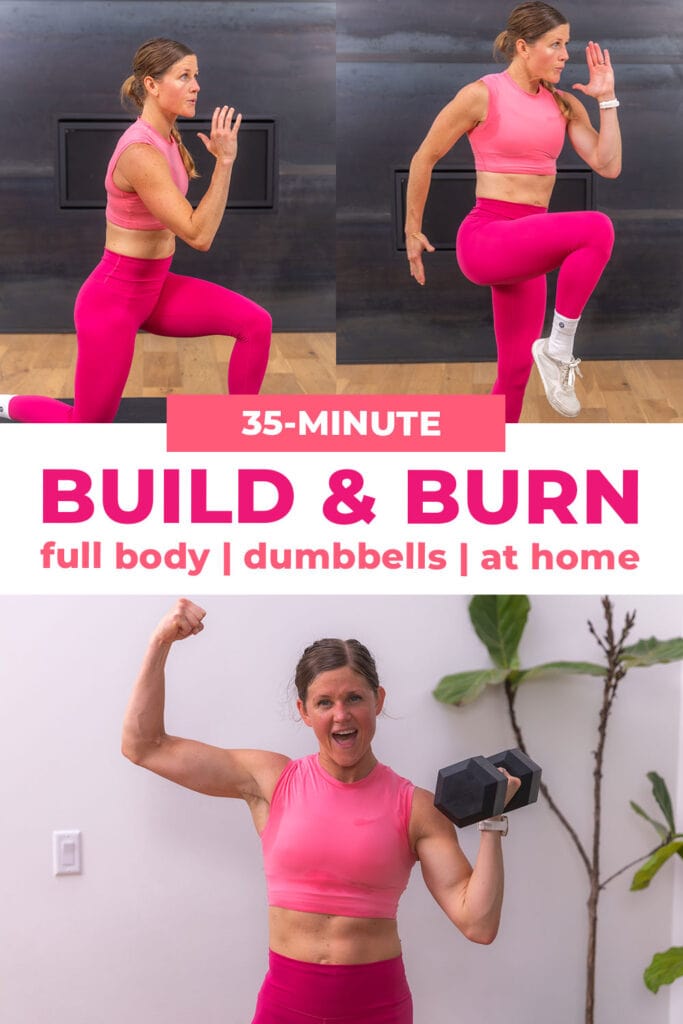










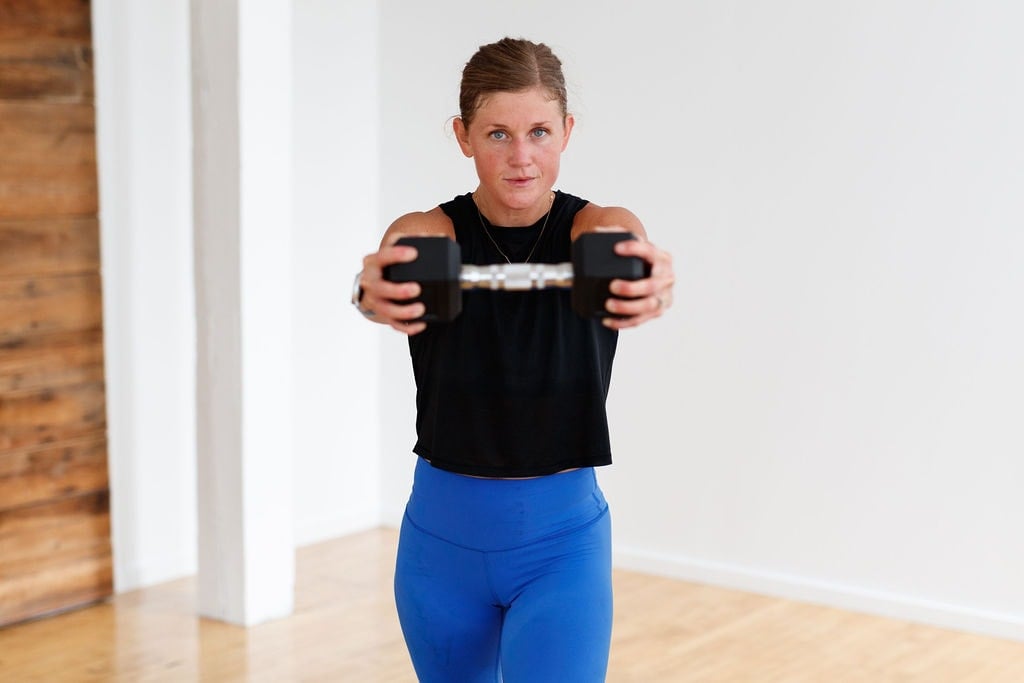
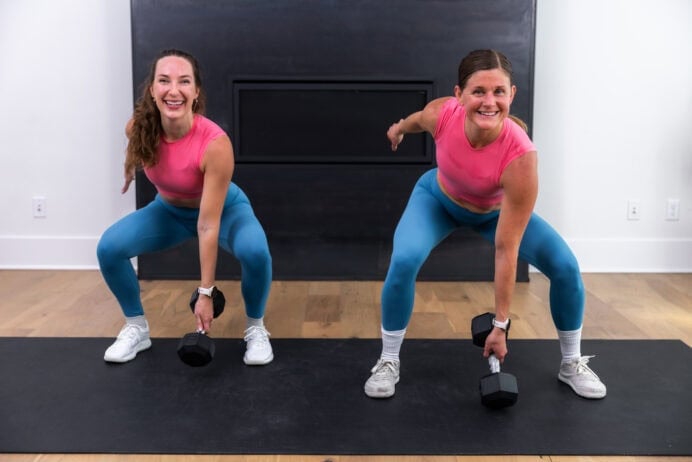
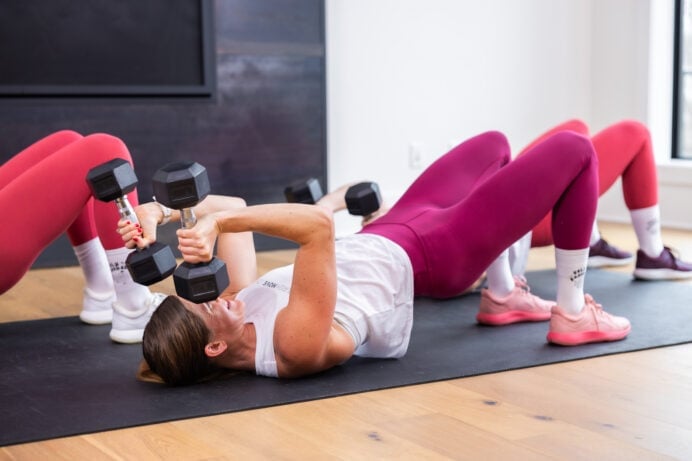
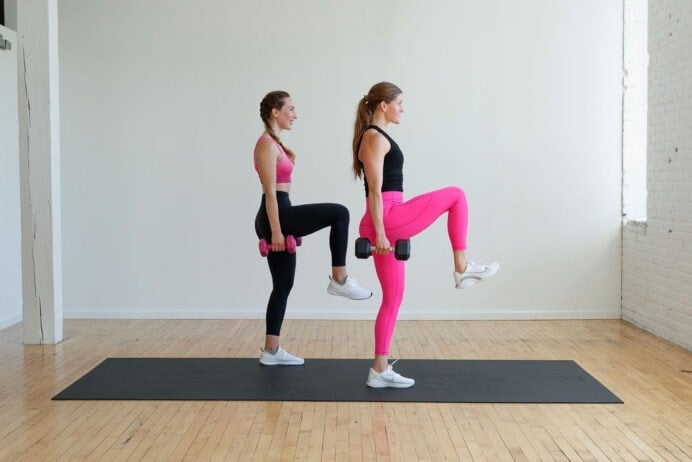
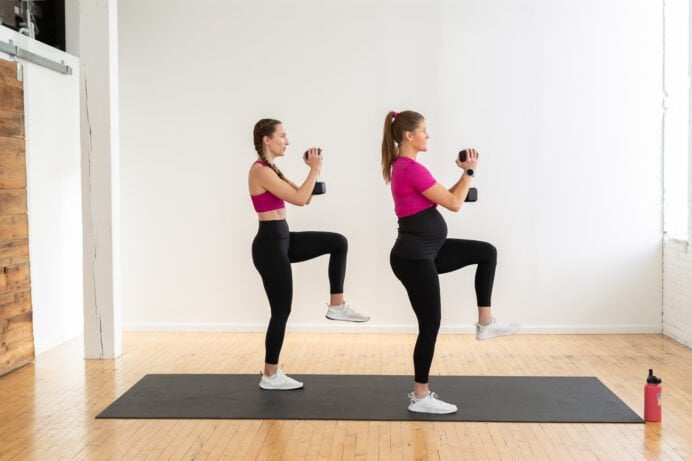
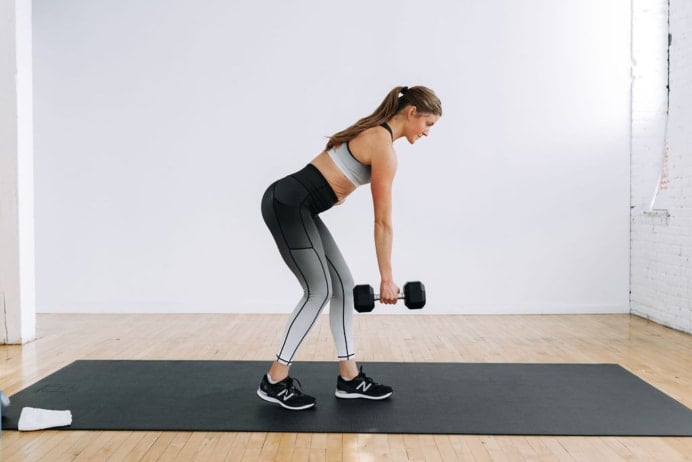


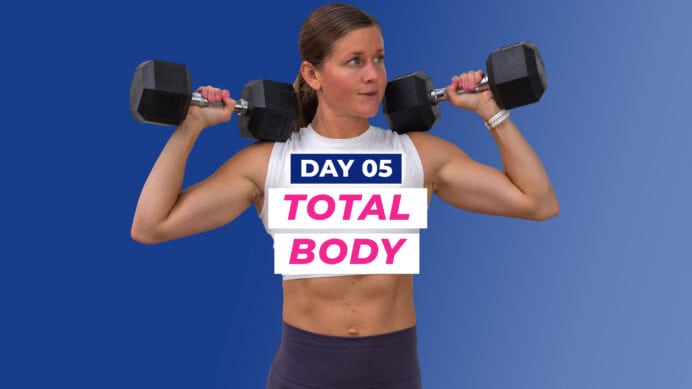
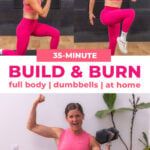
I love this format and new workout! Such a solid all-around workout! I always appreciate your focus on proper form and your encouragement to keep doing our best. Thanks for the new content and for always giving your all for the NML community!
Hi Sarah! Thank you so much for the kind words! I am so glad to hear you enjoyed the format of this strength + conditioning workout. Thanks for following along with NML and putting the workouts to such good use. Keep up the great work! -Lindsey